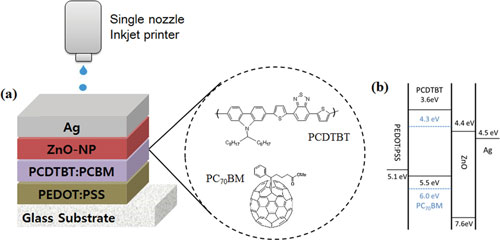| Posted: Jun 16, 2014 | |
Complete solar cells printed by inkjet |
|
| (Nanowerk Spotlight) Organic photovoltaic (OPV) technologies have the potential to become a thin-film alternative to inorganic silicon photovoltaics due to their intrinsic potential for low-cost print processing from solution – high-speed and at low temperature. Organic solar cells can be integrated into building facades and windows because they are optically translucent and can be manufactured on large areas at high throughput. | |
| "Despite impressive progress over the past decade, OPVs are still some way behind other thin-film technologies harvesting solar energy because of low efficiencies and short lifetimes," Sungjune Jung, an Assistant Professor in the Department of Creative IT Engineering at Pohang University of Science and Technology (POSTECH) in South Korea, tells Nanowerk. "To date, no route is available for monolithically integrating solar cells into a system in which other components such as transistors, sensors, or displays are already fabricated." | |
| Jung is first author of a recent paper in Advanced Energy Materials ("All-Inkjet-Printed, All-Air-Processed Solar Cells") where he and and international team of researchers report for the first time the fabrication and measurement of all-inkjet-printed, all-air-processed organic solar cells. | |
 |
|
| a) Device structure of an inkjet-printed solar cell and b) energy level diagram of its components. All the four layers are printed using a single nozzle inkjet printer and all the fabrication processes including printing, annealing and measuring have been performed in air at room temperature. (Reprinted with permission by Wiley-VCH Verlag) (click on image to enlarge) | |
| Inkjet printing has already proven effective in fabrication of OLEDs ("Cheaper, 'greener' lighting with inkjet-printed hybrid quantum dot LEDs"), printed electronics ("Inkjet printing of graphene for flexible electronics"), and photodetectors ("Low-cost inkjet printing of nanocrystal photodetectors"). | |
| "In our recent work, we demonstrate a high-efficiency solar cell with a homogeneous inkjet-printed donor-acceptor thin-film which was achieved by engineering the semiconducting blend ink with a tailored ternary solvent," explains Jung. "The results show that our inkjet-printed blend layer exhibits similar nanoscale structure and excited state dynamics to its spin-coated counterparts." | |
| Notably, all the four layers of the solar cell are printed at ambient temperatures. The team achieved a power conversion efficiency (PCE) of about 2% with all-inkjet-printed organic solar cells. They achieved a 5% PCE with a printed three-layer structure with the cathode as the only non-printed layer (made by evaporation). | |
| "Overall, our results show that inkjet-printing is an attractive digital printing technology for cost-effective, environmentally-friendly integration of photovoltaic cells onto plastic substrates," says Jung. "With this inkjet printing technique, we could integrate the energy harvesting units into a system where other components such as transistors, sensors or displays are already fabricated." | |
| These means that these inkjet-printed solar cells could allow for full integration into the manufacturing process of portable flexible electronic systems. | |
| Jung cautions, though, that in order to make this happen,the efficiency of the all-inkjet-printed all-air-processed solar cells need to be increased by further developing the processes and materials optimized for inkjet-printing. | |
 By
Michael
Berger
– Michael is author of three books by the Royal Society of Chemistry:
Nano-Society: Pushing the Boundaries of Technology,
Nanotechnology: The Future is Tiny, and
Nanoengineering: The Skills and Tools Making Technology Invisible
Copyright ©
Nanowerk LLC
By
Michael
Berger
– Michael is author of three books by the Royal Society of Chemistry:
Nano-Society: Pushing the Boundaries of Technology,
Nanotechnology: The Future is Tiny, and
Nanoengineering: The Skills and Tools Making Technology Invisible
Copyright ©
Nanowerk LLC
|
|
|
Become a Spotlight guest author! Join our large and growing group of guest contributors. Have you just published a scientific paper or have other exciting developments to share with the nanotechnology community? Here is how to publish on nanowerk.com. |
|
